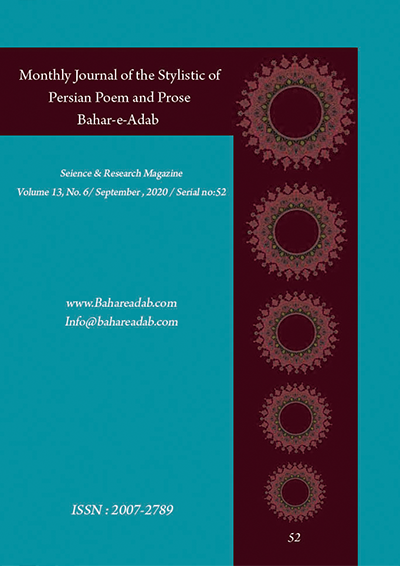- Count View : 497
- آدرس کوتاه شده مقاله: https://bahareadab.com/article_id/981
Journal of the stylistic of Persian poem and prose
volume Number 13،
number In Volume 6،
،
issue Number 52
Introduction to types and how to use the symbol of the Holy Defense Poetry
Sedigheh Rasolian (Author in Charge), Mahboobe Mobasheri
Abstract
"Symbol" is a word that also means apparent to the reader the whole wide meaning and practice of using or how to apply, and processing concepts become the symbol of the "symbolism", said. One can be extended metaphor prayer with the difference that the symbol rather than a hidden meaning are faced with a range of meanings and also no evidence Sarfh.Because of the diverse nature and mysterious symbol has also been influenced by the social and political conditions, its importance in contemporary poetry and the poetry of sacred defense is very high. So the important thing is that we are faced with a variety of symbols, features and quality of their applications in the field of poetry. This study investigates to get reliable answers to this symbol in the seventeenth Congress of Sacred Defense poetry and the poetry greats such as Salman Harati, Hassan Hosseini and Tahereh Saffarzadeh. Symbols in the Sacred Defense poetry, the components and elements of the two groups of icons and symbols of the abnormal nature of the semantic divide into two symbols of black and white icons. Of course, in this context, as opposed to semantic and symbolic concepts of evolution and expansion of its main features are considered. Identify symbols and explore its implications for understanding poetry is very important and useful, so close to its categories (like metaphors that are similar to the symbol) identified and separated.Typically the application icon in the Sacred Defense poetry following two modes: the richness of literary poet or poem no more symbolic space, symbol applies, or the atmosphere of the poem is symbolic. In this case, to achieve meaning and correct image of poetry, symbols must be considered in relation to each other. White symbol frequency Sacred Defense poetry lot of black icons (to induce positive meanings of concepts) and to visualize concepts around two axes of good and evil in contrast to many of the white symbols are symbols of black or symbolic texture creation or evolution their meaning.
Keyword
symbol
, symbolism
, poetry
, stability
, Holy defense
- Ghobadi, Hossein Ali (2009) Ain Aineh, Tehran: Tarbiat Modares University Publishing Center
- Shafiee, Seyed Zia-ud-Din (2008), Arghoni Waves, Bandar Abbas: Foundation for the Preservation of Relics and the Dissemination of Sacred Defense Values
- Jung, Carl Gustav (1973), Man and His Symbols, translated by Aboutaleb Saremi, Tehran: Amirkabir
- Shamisa, Sirus (2002), Bayan, Tehran: Ferdows
- Esbati, Behrooz (1993), The Epic of Qalaqiran, Ilam: Foundation for the Preservation of Relics and the Publication of the Values of Sacred Defense
- Pournamdarian, T. and Khosravi Shakib, M. (2008), Transformation of Symbols in Contemporary Poetry, Journal of Persian Language and Literature Research, No. 11 p. 147
- Saffarzadeh, Tahereh (2005), Didar Sobh, Tehran: Pars Ketab
- Pournamdarian, Taghi (1988), Mysteries and Mysterious Stories in Persian Literature, Tehran: Elmi va Farhangi
- Qazveh, Alireza (2005), The Fourteenth Narration, Kermanshah: Foundation for the Preservation of Relics and the Publication of the Values of Sacred Defense
- Saffarzadeh, Tahereh (2005), Road Enlightenment, Tehran: Barg zetun
- Esrafili, Hossein (2006), Apple Wound, Urmia Foundation for the Preservation of Relics and Publication of Sacred Defense Values
- Braheni, Reza (1992), Gold in Copper, Tehran: Nevisandeh
- Serlo, Juan Eduardo (2010), Culture of Symbols, translated by Mehrangiz Ouhadi, Tehran: Dastan
- Dehkhoda, Ali Akbar (2006), Dictionary, Tehran: University of Tehran
- Herati, Salman (2001), Divan of Salman Herati, Tehran: Young Poetry Office
- Beigi Habibabadi, Parviz (1995), Red Suddenness, Dezful: Foundation for the Preservation of Relics and the Dissemination of Sacred Defense Values
- Ghobadi, H. (1995), A Theory of Symbolism and Its Difference and Share with Metaphor and Irony, Journal of the Faculty of LiteratureFerdowsi University of Mashhad, No. 110, p. 347
- Hosseini, Hassan (2006), in unison with Ismail's throat, Tehran: Surah Mehr

